Age and Sex Influence the Use of Modular Femoral Components in Total Hip Arthroplasty Performed for Primary Osteoarthritis
Abstract
1. Introduction
2. Materials and Methods
3. Results
3.1. Stem Size
3.2. Neck Choice
3.3. Stem Size and Neck Choice
4. Discussion
5. Conclusions
Author Contributions
Funding
Institutional Review Board Statement
Informed Consent Statement
Data Availability Statement
Conflicts of Interest
References
- Traina, F.; De Clerico, M.; Biondi, F.; Pilla, F.; Tassinari, E.; Toni, A. Sex differences in hip morphology: Is stem modularity effective for total hip replacement? J. Bone Jt. Surg. Am. 2009, 91, 121–128. [Google Scholar]
- Boese, C.K.; Jostmeier, J.; Oppermann, J.; Dargel, J.; Chang, D.H.; Eysel, P.; Lechler, P. The neck shaft angle: CT reference values of 800 adult hips. Skelet. Radiol. 2016, 45, 455–463. [Google Scholar] [CrossRef]
- Sparks, C.A.; Decker, S.J.; Ford, J.M. Three-dimensional morphological analysis of sex, age, and symmetry of proximal femurs from computed tomography: Application to total hip arthroplasty. Clin. Anat. 2020, 33, 731–738. [Google Scholar] [PubMed]
- Carmona, M.; Tzioupis, C.; LiArno, S.; Faizan, A.; Argenson, J.N.; Ollivier, M. Upper femur anatomy depends on age and gender: A three-dimensional computed tomography comparative bone morphometric analysis of 628 healthy patients’ hips. J. Arthroplast. 2019, 34, 2487–2493. [Google Scholar]
- Warnock, J.M.; Karayiannis, P.N.; Gallagher, N.E.; Hill, J.C.; Beverland, D.E. Are there gender-specific errors in restoration of hip biomechanics that affect outcome following total hip arthroplasty? J. Arthroplast. 2020, 35, 1424–1431. [Google Scholar] [CrossRef] [PubMed]
- Ammarullah, M.I.; Santoso, G.; Sugiharto, S.; Supriyono, T.; Wibowo, D.B.; Kurdi, O.; Tauviqirrahman, M.; Jamari, J. Minimizing risk of failure from ceramic-on-ceramic total hip prosthesis by selecting ceramic materials based on Tresca stress. Sustainability 2022, 14, 13413. [Google Scholar] [CrossRef]
- Toni, A.; Castagnini, F.; Stea, S. Reproducing the proximal femur anatomy: Modular femoral component. In Personalized Hip and Knee Joint Replacement; Rivière, C., Vendittoli, P.A., Eds.; Springer: Cham, Switzerland, 2020; Chapter 8. [Google Scholar]
- Duwelius, P.J.; Burkhart, B.; Carnahan, C.; Branam, G.; Ko, L.M.; Wu, Y.; Froemke, C.; Wang, L.; Grunkemeier, G. Modular versus nonmodular neck femoral implants in primary total hip arthroplasty: Which is better? Clin. Orthop. Relat. Res. 2014, 472, 1240–1245. [Google Scholar]
- Graves, S.E.; de Steiger, R.; Davidson, D.; Donnelly, W.; Rainbird, S.; Lorimer, M.F.; Cashman, K.S.; Vial, R.J. The use of femoral stems with exchangeable necks in primary total hip arthroplasty increases the rate of revision. Bone Jt. J. 2017, 99, 766–773. [Google Scholar] [CrossRef]
- Castagnini, F.; Cosentino, M.; Bordini, B.; Montalti, M.; Biondi, F.; Faldini, C.; Traina, F. Titanium modular stems in total hip arthroplasty due to developmental dysplasia: A registry comparison with single-taper implants. Hip Int. 2022, 20, 11207000221124115. [Google Scholar] [CrossRef]
- Di Martino, A.; Castagnini, F.; Stefanini, N.; Bordini, B.; Geraci, G.; Pilla, F.; Traina, F.; Faldini, C. Survival rates and reasons for revision of different stem designs in total hip arthroplasty for developmental dysplasia: A regional registry study. J. Orthop. Traumatol. 2021, 22, 29. [Google Scholar] [CrossRef]
- ISAR. Available online: https://www.isarhome.org/ (accessed on 6 November 2021).
- Apta Stem. Available online: http://www.rpa.spot.pt/getdoc/638af724-9f7a-40e9-965c-ba64eb74451b/APTA-Modular-Hip-System.aspx (accessed on 6 November 2021).
- Ollivier, M.; Parratte, S.; Galland, A.; Lunebourg, A.; Flecher, X.; Argenson, J.N. Titanium-titanium modular neck for primary THA. Result of a prospective series of 170 cemented THA with a minimum follow-up of 5 years. Orthop. Traumatol. Surg. Res. 2015, 101, 137–142. [Google Scholar] [CrossRef] [PubMed]
- R Core Team. R: A Language and Environment for Statistical Computing; R Foundation for Statistical Computing: Wien, Austria, 2020; Available online: https://www.R-project.org/ (accessed on 21 November 2021).
- Akoglu, H. User’s guide to correlation coefficients. Turk. J. Emerg. Med. 2018, 18, 91–93. [Google Scholar] [CrossRef] [PubMed]
- Murphy, M.P.; Boubekri, A.M.; Myall, J.J.; Ralles, S.J.; Brown, N.M. Demographic data reliably predicts total hip arthroplasty component size. J. Arthroplast. 2022, 37, S890–S894. [Google Scholar] [CrossRef] [PubMed]
- Yin, Y.; Zhang, R.; Jin, L.; Li, S.; Hou, Z.; Zhang, Y. The hip morphology changes with ageing in Asian population. Biomed. Res. Int. 2018, 2018, 1507979. [Google Scholar] [PubMed]
- Edwards, K.; Leyland, K.M.; Sanchez-Santos, M.T.; Arden, C.P.; Spector, T.D.; Nelson, A.E.; Jordan, J.M.; Nevitt, M.; Hunter, D.J.; Arden, N.K. Differences between race and sex in measures of hip morphology: A population-based comparative study. Osteoarthr. Cartil. 2020, 28, 189–200. [Google Scholar]
- Pierrepont, J.W.; Marel, E.; Baré, J.V.; Walter, L.R.; Stambouzou, C.Z.; Solomon, M.I.; McMahon, S.; Shimmin, A.J. Variation in femoral anteversion in patients requiring total hip replacement. Hip Int. 2020, 30, 281–287. [Google Scholar] [CrossRef]
- Taniguchi, N.; Jinno, T.; Koga, D.; Hagino, T.; Okawa, A.; Haro, H. Cementless hip stem anteversion in the dysplastic hip: A comparison of tapered wedge vs. metaphyseal filling. J. Arthroplast. 2017, 32, 1547–1552. [Google Scholar]
- Castagnini, F.; Lucchini, S.; Bordini, B.; Cosentino, M.; Pardo, F.; Traina, F. Which stem in total hip arthroplasty for developmental hip dysplasia? A comparative study using a 3D CT-based software for pre-operative surgical planning. J. Orthop. Traumatol. 2022, 23, 33. [Google Scholar] [CrossRef]
- Boese, C.K.; Dargel, J.; Jostmeier, J.; Eysel, P.; Frink, M.; Lechler, P. Agreement between proximal femoral geometry and component design in total hip arthroplasty: Implications for implant choice. J. Arthroplast. 2016, 31, 1842–1848. [Google Scholar] [CrossRef]
- Wei, J.C.J.; Blaauw, B.; Van Der Pol, D.G.M.; Saldivar, M.C.; Lai, C.F.; Dankelman, J.; Horeman, T. Design of an affordable, modular implant device for soft tissue tension assessment and range of motion tracking during total hip arthroplasty. IEEE J. Transl. Eng. Health Med. 2022, 10, 2500310. [Google Scholar] [CrossRef]
- Ammarullah, M.I.; Santoso, G.; Sugiharto, S.; Supriyono, T.; Kurdi, O.; Tauviqirrahman, M.; Winarni, T.I.; Jamari, J. Tresca Stress study of CoCrMo-on-CoCrMo bearings based on body mass index using 2D computational model. J. Tribol. 2022, 33, 31–38. [Google Scholar]
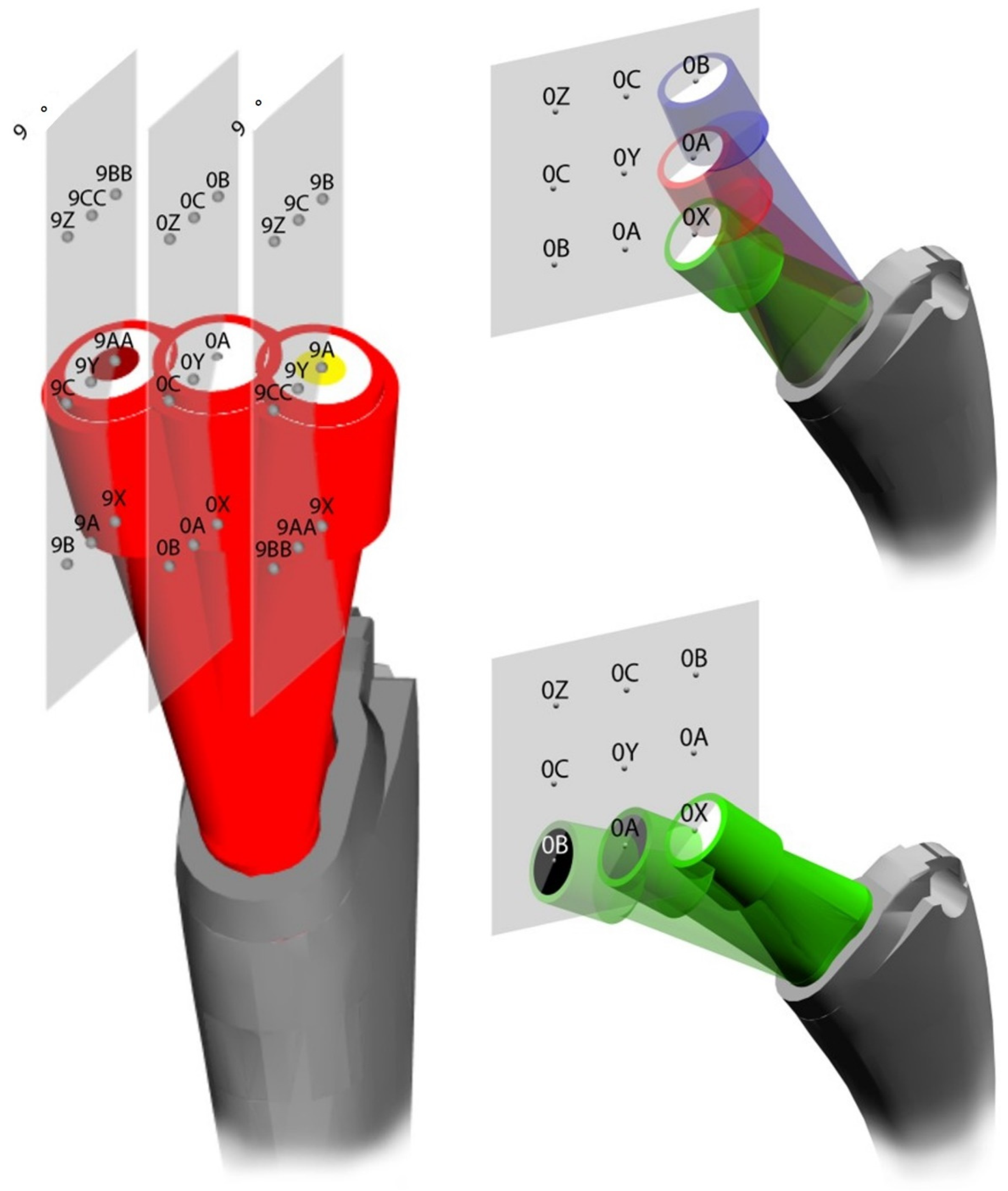
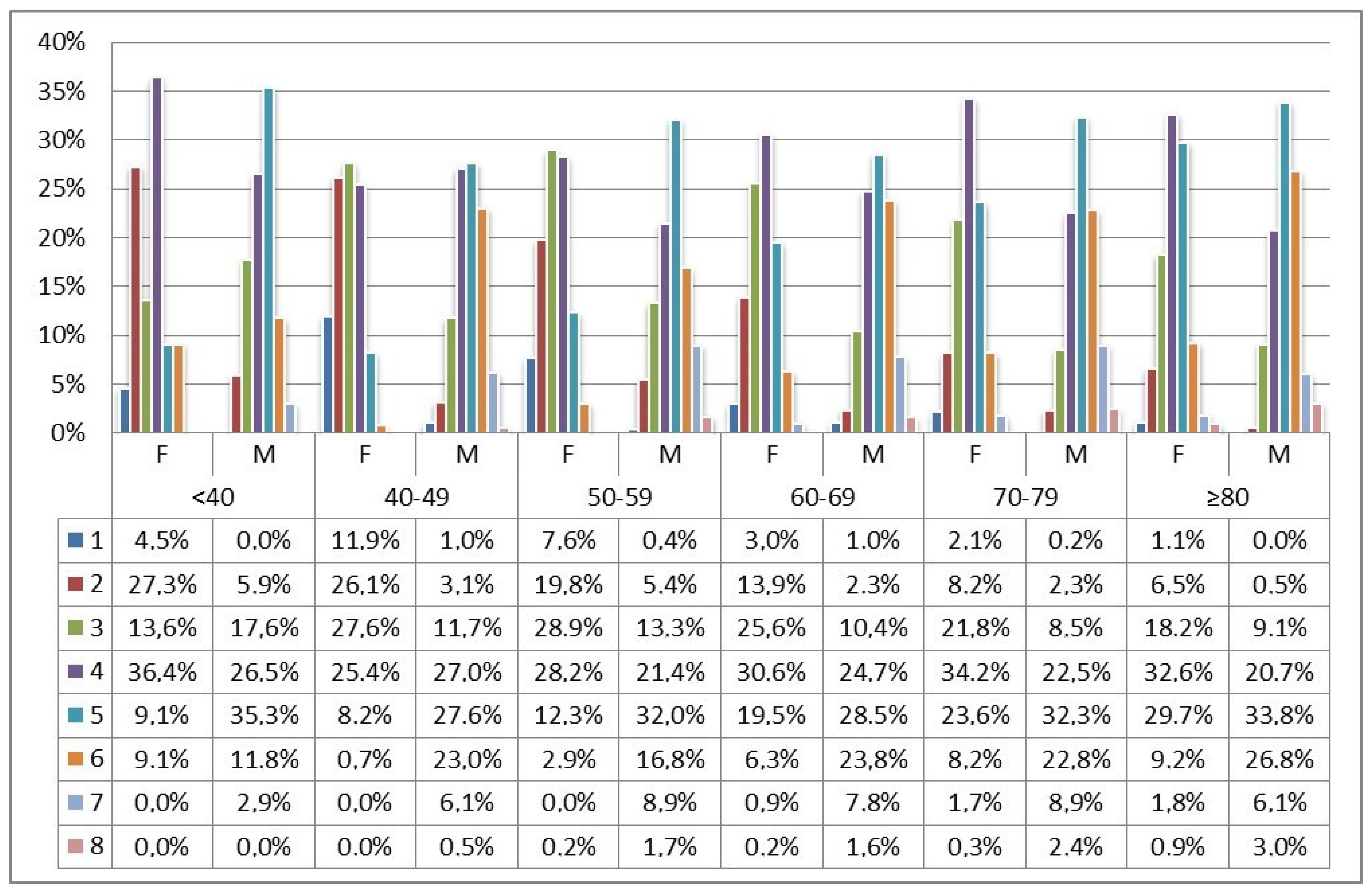
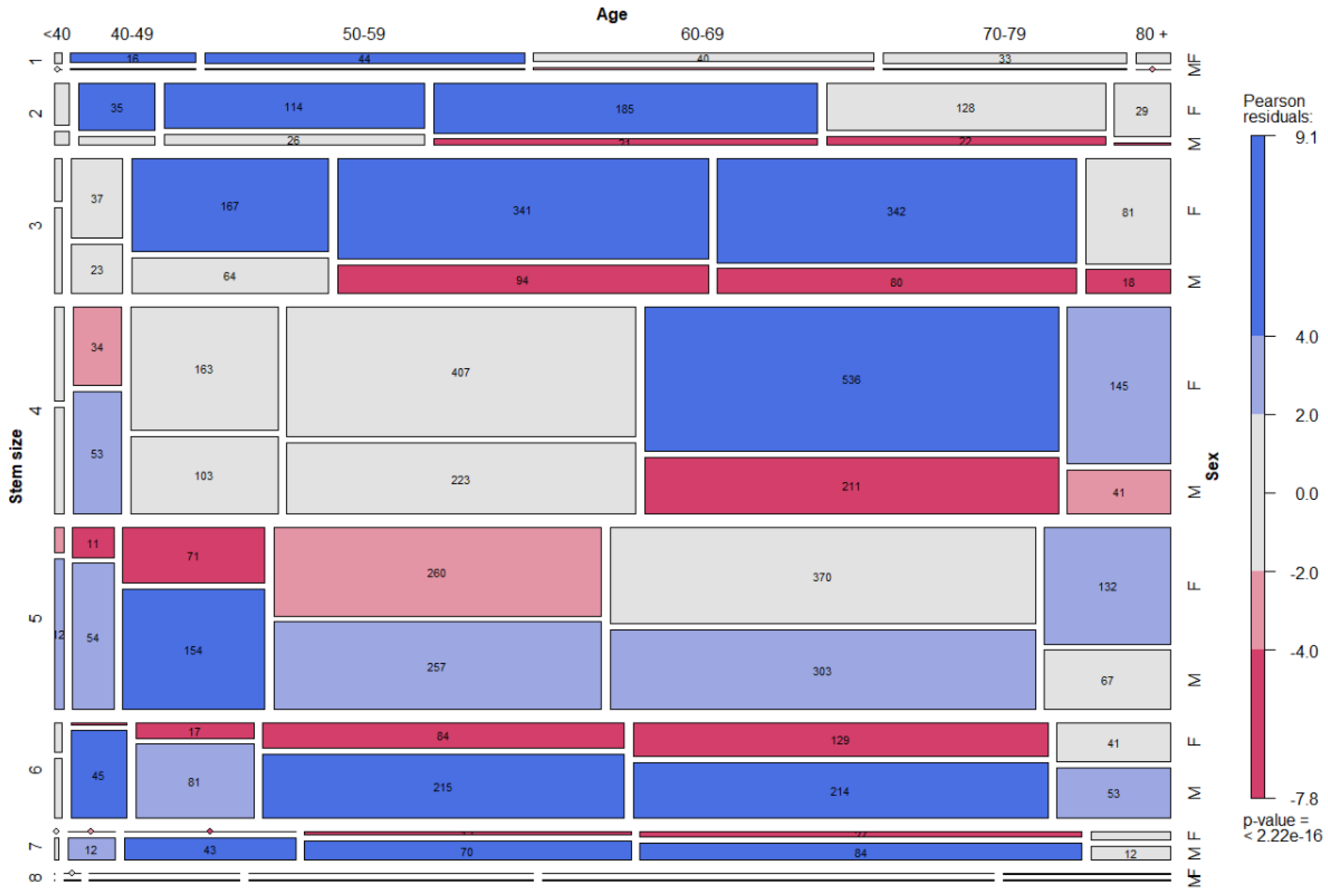
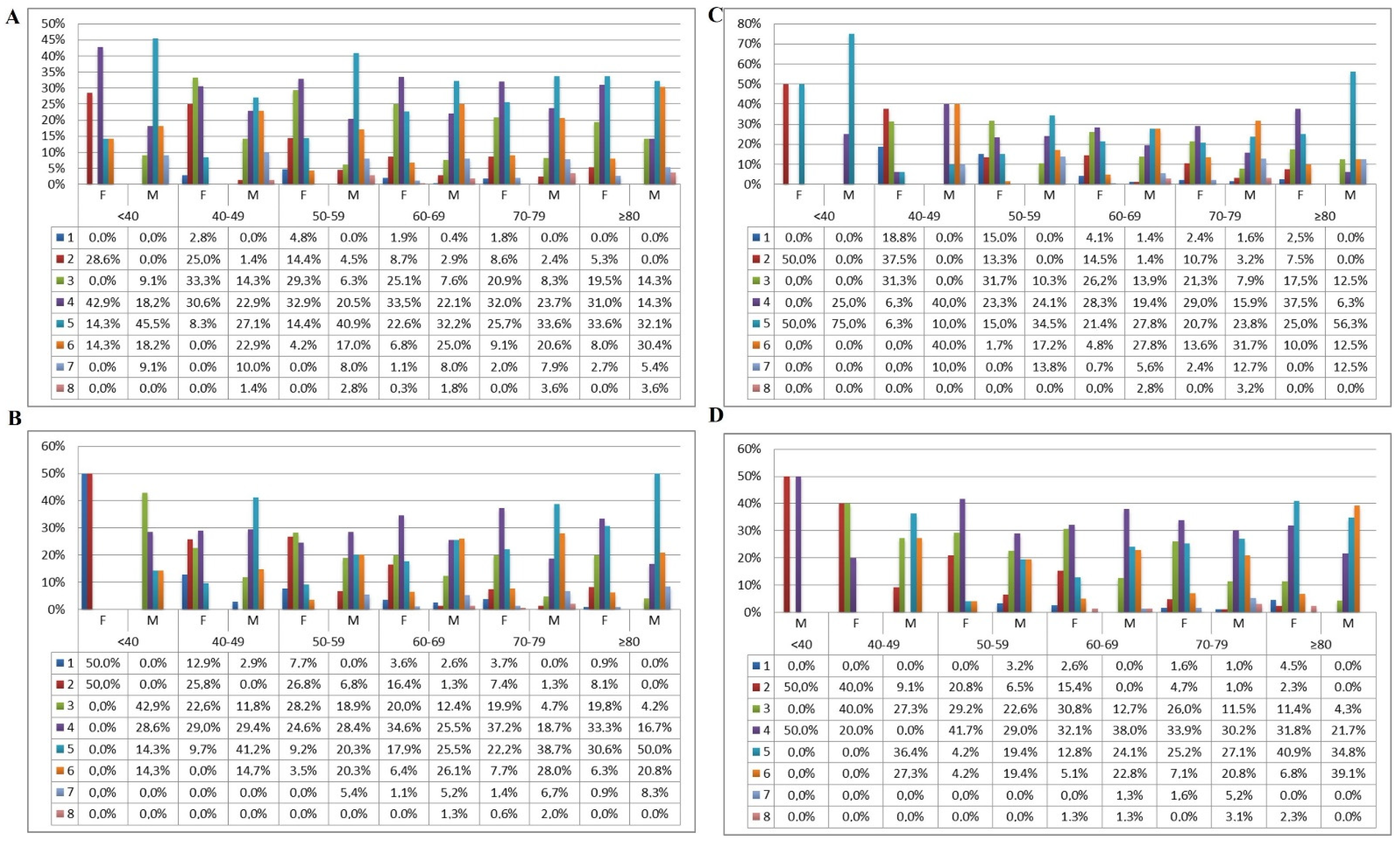
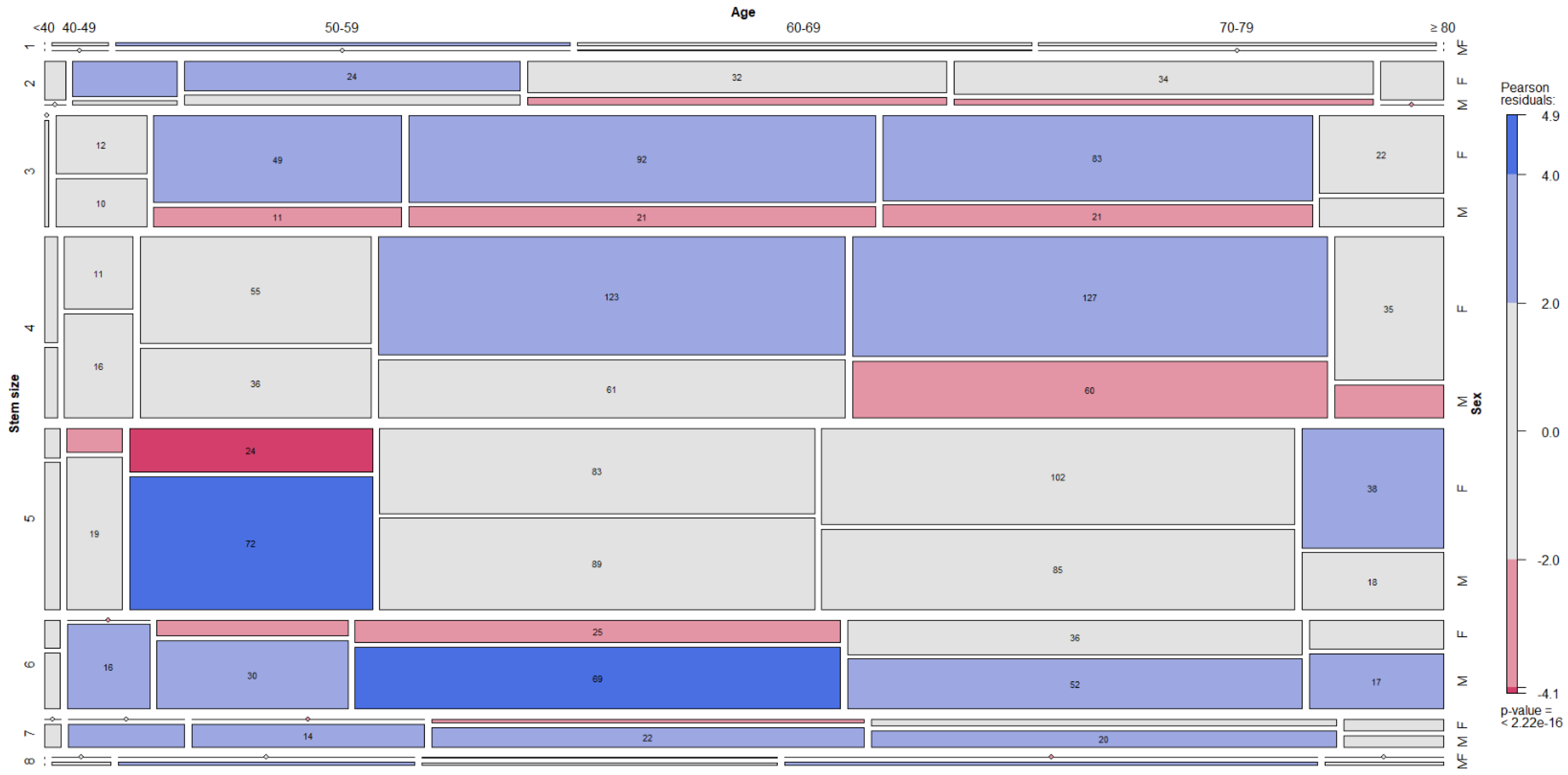
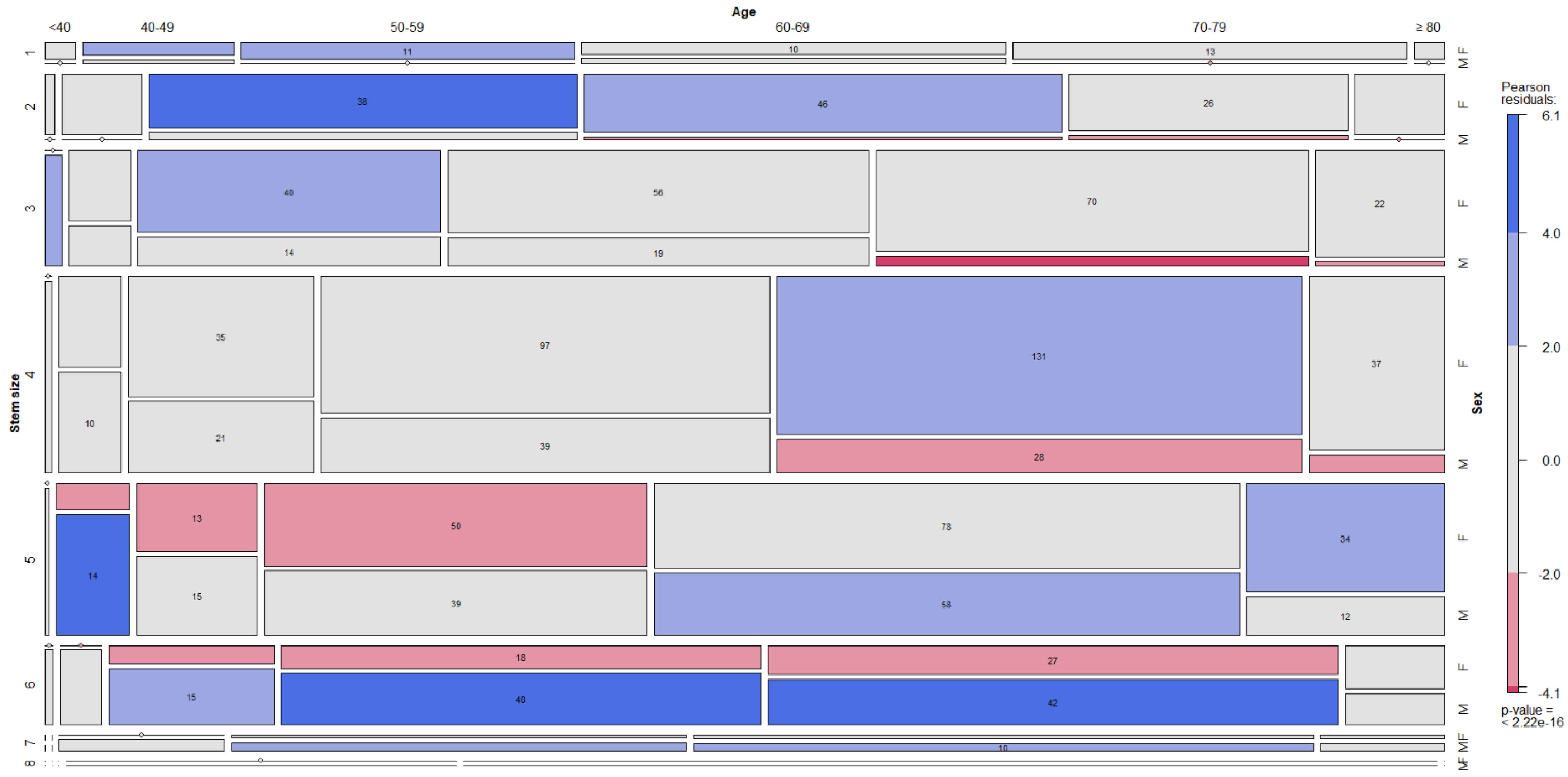
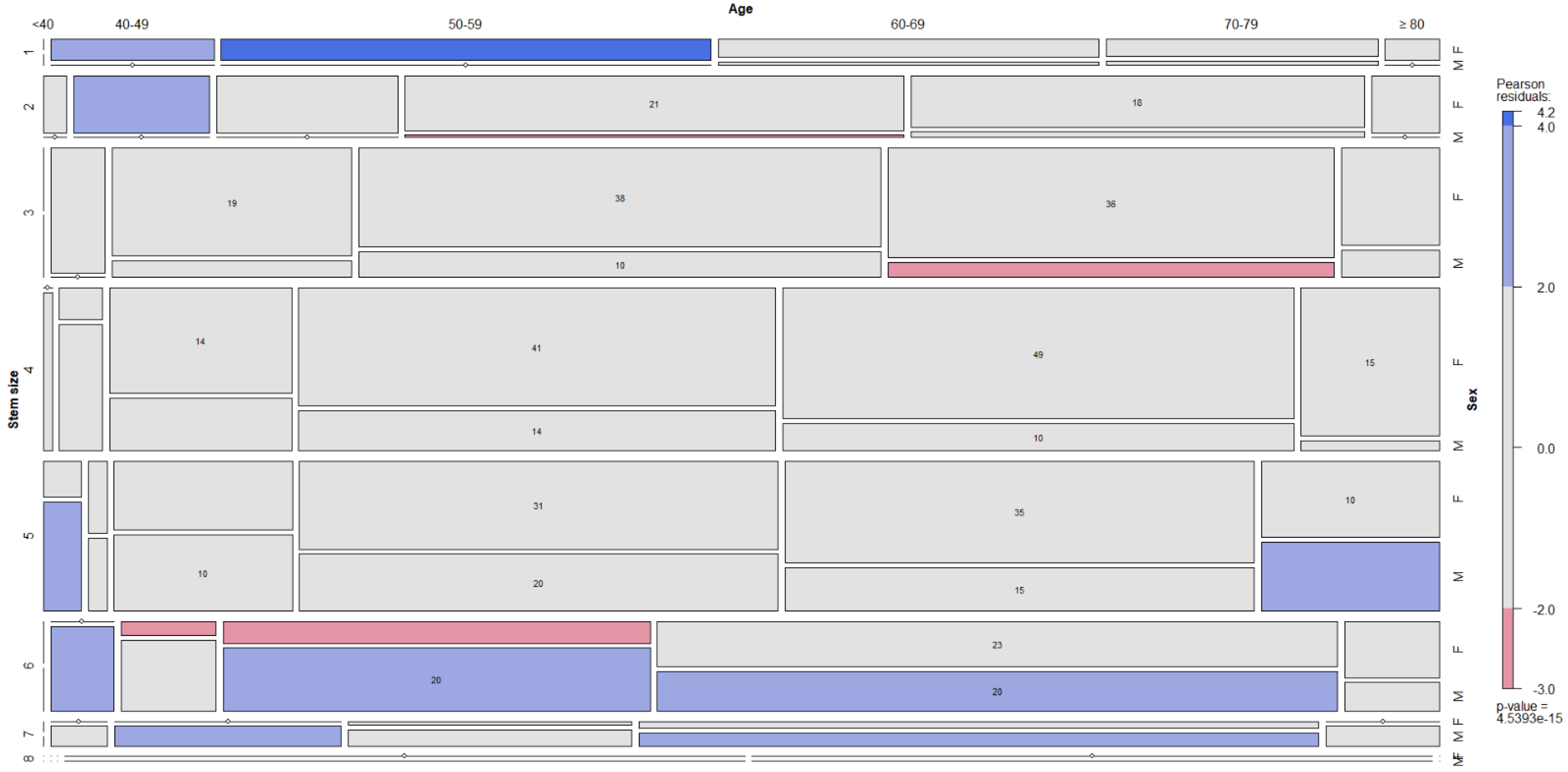

| Number of THA | Percentage of THA | Mean Weight (kg) | Range Weight (kg) | Mean Height (cm) | Range Height (cm) | Normal BMI (Percentage Females-Men) | Overweight BMI (Percentage Females-Men) | Obese BMI (Percentage Females-Men) | |
|---|---|---|---|---|---|---|---|---|---|
| Female | 4079 | 59.7 | 69.5 | 38–170 | 161.0 | 130–184 | 70.1 | 53.2 | 58.4 |
| <40 | 22 | 0.5 | 69.0 | 49–112 | 165.6 | 156–184 | 0.9 | 0.2 | 0.4 |
| 40–49 | 134 | 3.3 | 67.9 | 45–100 | 163.3 | 148–180 | 4.9 | 2.4 | 2.6 |
| 50–59 | 577 | 14.1 | 71.3 | 45–125 | 162.6 | 140–180 | 14.3 | 12.6 | 16.6 |
| 60–69 | 1332 | 32.7 | 70.4 | 43–170 | 161.1 | 137–180 | 29.9 | 33.4 | 35.3 |
| 70–79 | 1569 | 38.5 | 69.2 | 38–120 | 160.3 | 130–178 | 37.0 | 40.0 | 39.2 |
| ≥80 | 445 | 10.9 | 65.9 | 41–118 | 160.0 | 135–175 | 12.9 | 11.4 | 6.0 |
| Male | 2751 | 40.3 | 82.1 | 44–142 | 172.2 | 145–200 | 29.9 | 46.8 | 41.6 |
| <40 | 34 | 1.2 | 84.1 | 64–106 | 176.7 | 163–195 | 1.4 | 1.4 | 1.0 |
| 40–49 | 196 | 7.1 | 84.8 | 57–128 | 176.1 | 155–194 | 10.0 | 6.2 | 7.0 |
| 50–59 | 481 | 17.5 | 83.6 | 52–130 | 173.6 | 155–200 | 15.8 | 17.9 | 17.7 |
| 60–69 | 903 | 32.8 | 83.2 | 45–142 | 172.3 | 150–199 | 29.2 | 32.7 | 36.4 |
| 70–79 | 939 | 34.1 | 80.2 | 44–130 | 170.7 | 145–193 | 36.1 | 33.9 | 32.6 |
| ≥80 | 198 | 7.2 | 80.1 | 59–115 | 171.1 | 150–190 | 7.6 | 7.9 | 5.3 |
| Total | 6830 | 100.0 | 74.6 | 38–170 | 165.5 | 130–200 | 100.0 | 100.0 | 100.0 |
| Neck Type | <40 | 40–49 | 50–59 | 60–69 | 70–79 | ≥80 | |||||||
|---|---|---|---|---|---|---|---|---|---|---|---|---|---|
| F | M | F | M | F | M | F | M | F | M | F | M | Total | |
| Blue White | 0 | 0 | 0 | 0 | 0 | 0 | 1 | 0 | 1 | 0 | 0 | 0 | 0 |
| Blue Grey | 0 | 3 | 1 | 6 | 3 | 7 | 3 | 4 | 2 | 4 | 2 | 2 | 3 |
| Blue Black | 0 | 0 | 1 | 3 | 1 | 2 | 1 | 3 | 1 | 2 | 0 | 2 | 1 |
| Red White | 0 | 0 | 2 | 1 | 2 | 1 | 3 | 1 | 2 | 1 | 2 | 2 | 2 |
| Red Grey | 64 | 38 | 43 | 45 | 39 | 46 | 38 | 41 | 34 | 37 | 35 | 37 | 38 |
| Red Black | 0 | 9 | 5 | 9 | 6 | 8 | 7 | 11 | 10 | 14 | 12 | 14 | 11 |
| Green White | 0 | 0 | 3 | 0 | 1 | 0 | 1 | 0 | 1 | 1 | 2 | 1 | 1 |
| Green Grey | 27 | 38 | 41 | 31 | 40 | 28 | 40 | 31 | 41 | 29 | 41 | 30 | 36 |
| Green Black | 9 | 12 | 4 | 6 | 7 | 8 | 7 | 8 | 8 | 11 | 7 | 12 | 8 |
| Total | 100 | 100 | 100 | 100 | 100 | 100 | 100 | 100 | 100 | 100 | 100 | 100 | 100 |
| <40 | 40–49 | 50–59 | 60–69 | 70–79 | ≥80 | ||||||||
|---|---|---|---|---|---|---|---|---|---|---|---|---|---|
| F | M | F | M | F | M | F | M | F | M | F | M | Total | |
| Standard | 64 | 38 | 43 | 45 | 39 | 46 | 38 | 41 | 34 | 37 | 35 | 37 | 38 |
| Offset | 0 | 9 | 5 | 9 | 6 | 8 | 7 | 11 | 10 | 14 | 12 | 14 | 11 |
| Others | 36 | 53 | 62 | 46 | 55 | 46 | 55 | 48 | 56 | 49 | 53 | 48 | 51 |
| Total | 100 | 100 | 100 | 100 | 100 | 100 | 100 | 100 | 100 | 100 | 100 | 100 | 100 |
| <40 | 40–49 | 50–59 | 60–69 | 70–79 | ≥80 | ||||||||
|---|---|---|---|---|---|---|---|---|---|---|---|---|---|
| F | M | F | M | F | M | F | M | F | M | F | M | Total | |
| Neutral | 50 | 71 | 59 | 71 | 59 | 73 | 64 | 67 | 65 | 67 | 69 | 63 | 67 |
| Version | 50 | 29 | 41 | 29 | 31 | 27 | 36 | 33 | 35 | 33 | 31 | 37 | 33 |
| Total | 100 | 100 | 100 | 100 | 100 | 100 | 100 | 100 | 100 | 100 | 100 | 100 | 100 |
| <40 | 40–49 | 50–59 | 60–69 | 70–79 | ≥80 | ||||||||
|---|---|---|---|---|---|---|---|---|---|---|---|---|---|
| F | M | F | M | F | M | F | M | F | M | F | M | Total | |
| Blue | 0 | 3 | 1 | 8 | 5 | 9 | 4 | 7 | 4 | 6 | 2 | 4 | 5 |
| Red | 64 | 47 | 50 | 55 | 47 | 56 | 48 | 53 | 47 | 52 | 49 | 53 | 50 |
| Green | 36 | 50 | 49 | 37 | 48 | 36 | 48 | 40 | 50 | 41 | 49 | 43 | 45 |
| Total | 100 | 100 | 100 | 100 | 100 | 100 | 100 | 100 | 100 | 100 | 100 | 100 | 100 |
Disclaimer/Publisher’s Note: The statements, opinions and data contained in all publications are solely those of the individual author(s) and contributor(s) and not of MDPI and/or the editor(s). MDPI and/or the editor(s) disclaim responsibility for any injury to people or property resulting from any ideas, methods, instructions or products referred to in the content. |
© 2023 by the authors. Licensee MDPI, Basel, Switzerland. This article is an open access article distributed under the terms and conditions of the Creative Commons Attribution (CC BY) license (https://creativecommons.org/licenses/by/4.0/).
Share and Cite
Castagnini, F.; Bordini, B.; Cosentino, M.; Di Liddo, M.; Tella, G.; Masetti, C.; Traina, F. Age and Sex Influence the Use of Modular Femoral Components in Total Hip Arthroplasty Performed for Primary Osteoarthritis. J. Clin. Med. 2023, 12, 984. https://doi.org/10.3390/jcm12030984
Castagnini F, Bordini B, Cosentino M, Di Liddo M, Tella G, Masetti C, Traina F. Age and Sex Influence the Use of Modular Femoral Components in Total Hip Arthroplasty Performed for Primary Osteoarthritis. Journal of Clinical Medicine. 2023; 12(3):984. https://doi.org/10.3390/jcm12030984
Chicago/Turabian StyleCastagnini, Francesco, Barbara Bordini, Monica Cosentino, Michele Di Liddo, Giuseppe Tella, Claudio Masetti, and Francesco Traina. 2023. "Age and Sex Influence the Use of Modular Femoral Components in Total Hip Arthroplasty Performed for Primary Osteoarthritis" Journal of Clinical Medicine 12, no. 3: 984. https://doi.org/10.3390/jcm12030984
APA StyleCastagnini, F., Bordini, B., Cosentino, M., Di Liddo, M., Tella, G., Masetti, C., & Traina, F. (2023). Age and Sex Influence the Use of Modular Femoral Components in Total Hip Arthroplasty Performed for Primary Osteoarthritis. Journal of Clinical Medicine, 12(3), 984. https://doi.org/10.3390/jcm12030984







